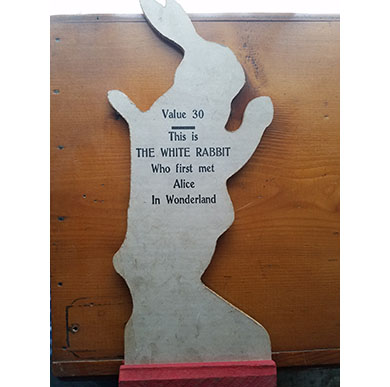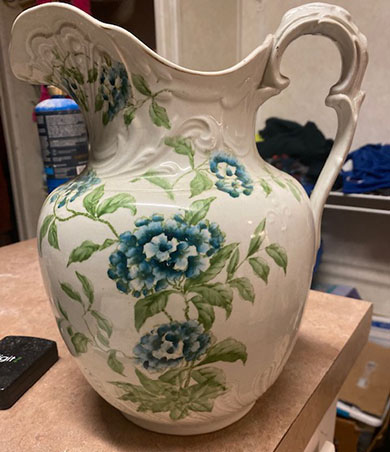 |
|
|||
 |
 |
|||
RINKER ON COLLECTIBLES — Column #1815 Copyright © Harry Rinker, LLC 2021 Questions
and Answers
QUESTION: Several months ago, I purchased an estate sale lot that consisted of 10 wood cutouts of Alice in Wonderland characters for $210.00. They range from 10 to 11 inches in height and are mounted on wooden stands. The color lithography still is very nice. Each figure is assigned a point value on the back. The back of the White Rabbit reads: “Value 30 / This is / THE WHITE RABBIT / Who first met / Alice / In Wonderland.” After some exhaustive researching, I found an online .pdf for the “McLoughlin Brothers’ Eighty-sixth Annual Catalogue of Games; ABC, Picture, and Building Blocks; Backgammon, Checker, and Chess Boards; Scroll Puzzles; Flags, Lead Soldiers; Etc.” (New York: McLoughlin Bros., 1914) on the website of the American Antiquarian Society (https://www.americanantiquarian.org/mcloughlin/003531.pdf). I do not have the period box or the balls. I currently display the pins on a shelf in my grandson’s bedroom. What is the collector value for such items? – MB, Webster, NY, Email Question 
ANSWER: Scottish immigrant John McLoughlin founded a small printing shop in Brooklyn, New York in 1828. John McLoughlin, Jr., developed the artistic and commercial roots of the firm. His younger brother Edmund McLoughlin became a partner in 1855. Shortly thereafter, McLoughlin Bros. became a major manufacturer of board games, card games, chapbooks, children’s books in a variety of formats such as hardcover and linen, paper dolls, puzzles, and more. McLoughlin was noted for its high-quality lithography. Milton Bradley acquired McLoughlin Bros. in 1920. Pages 65 and 66 of the McLoughlin 1914 catalog focused on McLoughlin’s “Ten Pins” games. The list is impressive—Soldier Ten Pins (No. 661), Animal Ten Pins (No. 7676), Soldier Ten Pins (No. 7674), Jollie Darkie Ten Pins (No. 7655), Pussy Cat Ten Pins (No. 7675), Boys Scout Ten Pins (No 7673), Furry Creatures Ten Pins (No. 665), Brownie Nine Pins (No. 663), Punch and Judy Ten Pins (No. 677), and Alice in Wonderland Ten Pins (No. 7700). Ten Pin sets with 600 numbers were introduced early in the first decade of the 20th century. The suggested retail price for the Alice in Wonderland Game was $1.00. The box size was 27 inches by 12 1/2 inches. The catalog description reads: “This set has large character pins taken from the famous book. There is a set of balls in each box. All printed in full lithograph colors. / Put up in 1/2 dozens.” Complete boxed sets of McLoughlin ten pins command premium prices. WorthPoint’s Worthopedia has a listing for (1) a circa 1896, Yellow Kids Ten Pin Game that sold for $20,740.00, (2) a ca.1902 Punch & Judy Ten Pins Game that was sold for $4,636.00, (3) a Funny Creatures Ten Pins that sold for $2,684.00, and (4) a Jolly Darkie Ten Pins that sold for $1,342.00. All four sets were auctioned by Pook & Pook on April 23, 2021. A missing box and balls impact value by two-thirds or more compared to the value of a complete unit. Your ten Alice in Wonderland characters, based on comparable groups of McLoughlin ten pin figures without their box that I found on the internet are valued as a group between $300.00 and $350.00. 
QUESTION: I have an unusual Thorens music box. The background is a die-cut silhouette, pine tree forest. An A-frame, two-story Alpine building inside of which is a dining table with figures at each end is in front of the pine trees. Outside a figure of a bearded man walks toward the door opening to the A-frame. On the right is a young woman in native tracht (dress) standing on a pedestal that rotates as the music is played. The music box plays “Guten Abent, Gute Nacht” and operates electrically rather than via wind up. I cannot find any Thorens music boxes that remotely resemble this. What is its value? – S, NYC, NY, E-mail Question 
ANSWER: In 1883, Herman Thorens established a firm to make music box movements. The company was located in Ste. Croix, Switzerland. In addition to producing his own boxes, he supplied movements to third parties such as Anri, Silverite, and Fred Zimbalist. Eventually, the Thorens line was increased to include cylinder phonographs, gramophones, pocket lighters, shavers, skiing equipment, and more. Thorens merged with Paillard in 1963. Three years later, Thorens ended its relationship with Paillard and entered one with EMT, forming Thorens-Franz AG. In 1985-86, Reuge SA took over the production of the Thorens AD30 music boxes. Today, Thorens is a manufacturer of high-end audio equipment. Based on its style, your music box dates from the late 1940s through the 1950s. The figurines that appear in your box closely resemble those produced by nutcracker manufacturers located in the Erzgebirge region of southwest Germany. Although I was not able to find an exact match for your Thoren’s A-frame cottage music box on WorthPoint.com’s Worthopedia, I did find several comparable examples. An Anri “Silent Night” music box with a Thorens mechanism sold for $102.00 on July 15, 2021 on eBay. A 1950s Steinbach nativity scene music box with a Thorens mechanism sold for $300.00 on December 5, 2020 on eBay. Steinbach is a major Erzgebirge manufacturer. A fair secondary market value for your Thorens A-frame house music box, assuming it is in working condition, is between $150.00 and $175.00. QUESTION: I purchased two oil on canvas paintings, each featuring a pair of horses. The plaque on the bottom of the front of the frame reads “Niels Christansen 1873-1954.” The birth date for an N. Peter Christansen is the same. However, his death occurred in 1960. Perhaps he was not dead when the works were painted. The difficulty is that there are multiple Niels Christansens listed in art directories. Each painting measures 24-inches by 32 1/2 inches. How do I resolve my attribution dilemma? – AM, San Antonio, TX, E-mail Question ANSWER: The correct spelling for the painter is Christiansen, not Christansen. I checked Askart.com. The site listed over 50 paintings by Christiansen. First, the paintings were all pastoral landscapes. While the landscapes featured horses, cows, sheep, ducks, and other associated animals (singly or mixed) at a distance, none of the paintings featured a close up of a single or pair of animals. Second, all auction sales occurred in Europe, primarily Denmark. In 2018, a 19 1/2- inch by 46-inches painting of horses grazing in a field failed to sell at a low estimate of $226.00. In 2017, a landscape with cows and horses sold for $271.00 with a low estimate of $236.00. Third, none of the images featured a barn or similar background found in your painting. Fourth, all the above paintings are artist signed with a full signature or monogram. In conclusion, it makes little difference if your paintings were done by Niels Christiansen or not. Their resale value is decorating rather than collecting. You paid $200.00 for the pair, a bargain for two unsigned horse-theme paintings. You should be able to double your money when you wish to sell them. QUESTION: I have a large bulbous pitcher (it might be a cold-water pitcher from a toilet set) with a large floral motif. The mark on the bottom is a world globe with longitude and latitude lines and with a sword stuck through it from 1:30 to 7:30 o’clock. “BONA FAMA EST / MEILOR ZONA AUREA” surrounds the globe. Beneath this is “ALBA CHINA.” Since I could not find much information about my pitcher on the internet, I am wondering if it is scarce and worth a great deal of money. I would very much appreciate your input. – CS, Email Question 
ANSWER: The key to using the internet is knowing where to look. Your pitcher is not scarce nor extremely valuable. The mark on the bottom of your pitcher was used by the Edwin Bennett Pottery Company of Baltimore after 1890. James Bennett established a pottery in East Liverpool, Ohio, in 1839. In 1844, Daniel, Edwin, and James Bennett moved to Birmingham, Pennsylvania and started a small pottery company. Edwin Bennett moved to Baltimore, Maryland in 1846. There he founded the E. Bennett Chinaware Factory. As business grew, Bennett’s brother William joined the firm in 1848. The company became E. & W. Bennett until 1856. From 1856 to 1890, the company operated under the name Edwin Bennett Pottery. The company was renamed the Edwin Bennet Pottery Company in 1890 and operated under that name until its demise in 1936. The Latin motto “Bona Fama Est Melior Zona Aurea roughly translates as “A good reputation is better than a golden belt. “Alba” means white. The secondary market value of your pitcher is between $40.00 and $50.00. Harry L. Rinker welcomes questions from readers about
collectibles, those mass-produced items from the twentieth and twenty-first centuries.
Selected letters will be answered in this column.
Harry cannot provide personal answers.
Photos and other material submitted cannot be
returned.
Send your questions to: Rinker on Collectibles, 5955 Mill
Point Court SE, Kentwood, MI 49512.
You also can e-mail your questions to
harrylrinker@aol.com.
Only e-mails containing a full name and mailing address
will be considered.
|
||||